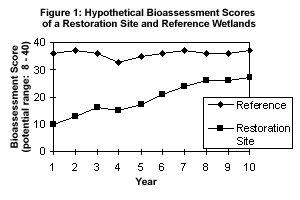Evaluating Performance of Wetland Restoration Activities
|
|
||
| United States Environmental Protection Agency |
Office of Water Office of Wetlands, Oceans and Watersheds (4502-F) |
EPA843-F-98-001h July 1998 |
|
|
||
Wetland Bioassessment Fact Sheet 8
Perhaps the most commonly neglected component of wetland restoration projects is a clearly defined approach to evaluate the success of the restoration activities. How well do current wetland restoration techniques work? Are they effective at restoring a balanced, adaptive community of plants and animals? How do the conditions in restoration sites compare to conditions in minimally impaired sites?
One way to tell if a wetland is recovering properly is to periodically assess the condition of one or more biological assemblages, such as plants, amphibians, or macroinvertebrates. Wetland managers can rapidly assess the condition of an assemblage using biological assessment methods based on a regionally appropriate index of biological integrity (IBI). An IBI is constructed by combining at least eight attributes of an assemblage that each show an empirical and predictable responses across a gradient of anthropogenic disturbance (See Fact Sheet 3). When applying an existing IBI to a new region or wetland type, make sure to validate the metrics and calibrate the IBI scores to regional conditions. Below are some helpful suggestions to keep in mind when using an IBI to track the recovery of a wetland.

- Compare restoration site to reference wetlands - Reference wetlands are minimally impaired sites that are representative of the expected ecological conditions and integrity of other wetlands of the same type and region. By comparing a biological assemblage (e.g., macroinvertebrates) of a restoration site to a similar assemblage found reference sites, wetland managers can determine the relative condition of the wetland. Figure 1 shows a hypothetical example of comparing the IBI scores of a restoration site to average IBI scores of reference wetlands over ten years.
- Track both reference wetlands and restoration sites - It is important to compare the IBI scores of the restoration site and reference sites from the same year to identify regional trends that may effect all wetlands in an area. For example, there may have been a drought in Year 4, which would account for the dip in the curves on Figure 1.
- Sample during proper time of year - Bioassessment protocols typically require that sampling be conducted within a certain time of the year, which is often called an index period. The diversity and composition of an assemblage can vary considerably at different times of the year. Sampling at the wrong time of year will provide data that can not be used. In addition, some assemblages can only be sampled at certain times of the year because of their seasonal life cycles. For example, the best time to sample adult frogs is during the breeding season when many species congregate in ponds and vernal pools.
| CASE STUDY: | USGS, Biological Resources Division, Patuxent Wildlife Research Center USDA Natural Resources Conservation Service, Wetlands Science Institute |
|
The interdisciplinary team of researchers is developing a biological assessment method to evaluate the success of wetland restoration activities. They are conducting research in Delmarva Bays, which are depressional, freshwater wetlands that are common on the Eastern Shore of Maryland. The wetlands in this study fall into two groups. The first group includes 24 wetlands which were previously used for agriculture and been restored during the past 10 years. The second group includes 10 minimally impaired wetlands, which they are using for reference wetlands. The reference wetlands are at different successional stages to help understand how the biological communities may change over time. Some of the reference wetlands have open water and emergent vegetation while others are only seasonally inundated and have trees. For each of the restoration and reference sites, the team or researchers is taking measurements of the following components of the wetland ecosystems:
Their goal is to identify reliable indicators of wetland condition. For each component, they are testing a variety of attributes to identify metrics that show clear, empirical changes in value across a gradient of disturbance, from the minimally impaired wetlands to the most severely degraded wetlands. They intend to develop standardized methods for gathering and analyzing these metrics. Eventually, they intend to develop IBIs for one or more assemblages (See Fact Sheet 5). After developing the IBIs, they will be able to determine the condition of other restored, depressional wetlands in the region. They will also gain valuable information about the effectiveness of different wetland restoration methods. |
|
Benefits of Evaluating Performance
In the long run, the cost of periodically conducting biological assessments will probably be small compared to benefits that come from such assessments. Wetland managers will benefit by:
- Determining the effectiveness of their methods and learning how to improve methods,
- Learning how to avoid common mistakes,
- Improving investment of restoration money and increasing ecological return of investments,
- Avoiding the substantial financial and ecological costs of spending money on ineffective restoration techniques and having to make second attempts at restoring sites,
- Recording the effects of extraneous events (e.g., drought, beaver activity) that may hinder recovery,
- Incorporating unexpected results into an adaptive management process or simply re-evaluating restoration objectives,
- Acquiring reliable, quantitative data that can help (1) communicate results to managers and the public, (2) resolve disputes, and (3) support grant applications to fund future projects.
![[logo] US EPA](logo_epaseal.gif)